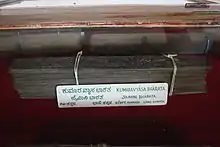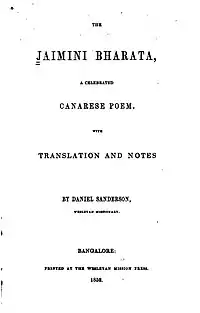Lakshmisa
Lakshmisa (or Lakshmisha, Kannada: ಲಕ್ಷ್ಮೀಶ) was a noted Kannada language Brahmin writer who lived during the mid-16th or late 17th century. His most important writing, Jaimini Bharata is a version of the Hindu epic Mahabharata. The writing focuses on the events following the battle of Indraprastha between the Pandavas and Kauravas, using the Ashvamedha ("horse sacrifice") conducted by Yudhishthira as the topic of the epic narrative. The writing is in the shatpadi metre (hexa-metre, 6 line verse) and was inspired by the Sanskrit original written by sage Jaimini.[1][2]
.JPG.webp)
Life

The place, time and religious sect that Lakshmisa belonged to has been a subject of controversy among historians. Some historians believe he was a native of Devanur in modern Kadur taluk, Chikkamagaluru district, Karnataka state. It is claimed that his family deity was "Lakshmiramana" (a form of Hindu God Vishnu) to whom he dedicated his writing. Devanur was called by multiple names in his writing; Surapura and Girvanapura.[3] Other historians feel Surapura is located in the erstwhile Hyderabad region. Some historians believe that Lakshmisa was an Advaitin or a Smartha Brahmin (believer of monistic philosophy) of the Bhagavata sect because the poet has invoked the names of Hindu God Shiva, his consort Parvati and son Ganapati in the beginning of his writing.[3] However, despite these invocations, he may have been a Srivaishnava (a follower of the Visishtadvaita philosophy preached by 12th century philosopher Ramanujacharya), there being examples of other Srivaishnava poets (who wrote in Kannada) who praised the God Shiva, Parvati and Ganapati in their writings.[4]
There is also controversy about when he wrote Jaimini Bharata. Scholars have assigned him various dates, the earliest being c. 1415,[4] but more generally mid–16th century,[5][6] and late 17th century.[1][4][7] The 16th century or earlier dating is based on similarities between Virupaksha Pandita's (1584 CE) Chennabasava Purana and Lakshmisa's work,[8] while the 17th century dating is based on the claim that no author, Brahmin or otherwise, has referenced his writing and directly mentioned his name in any literature during the period 15th century through late 17th century. Whereas, authors who do mention Lakshmisa regularly in their writings are from the 18th century.[4]
Magnum opus

The Jaimini Bharata, one of the most well known stories in Kannada literature was written in the tradition of sage Jaimini. It has remained popular through the centuries. In a writing full of similes and metaphors, puns and alliterations, Lakshmisa created a human tale out of an epic, earning him the honorific "Upamalola" ("One who revels in similes and metaphors") and "Nadalola" ("Master of melody").[5][6] The writing focusses on the events following the battle when the victorious Pandavas conducted the Ashvamedha Yagna to expiate the sin of fratricide. The writing differs entirely from Kumara Vyasa's rendering of the same epic (called Karnata Bharata Kathamanjari) of c. 1430, both in metre and content. Kumara Vyasa had used the flexible bhamini shatpadi metre and followed the Vyasa tradition whereas Lakshmisa used the vardhaka shatpadi metre which is well suited for figures of speech.[5] The work has been criticised though, for failing to achieve the level of devotion towards Hindu God Krishna that Kumara Vyasa managed in the various stages of his story.[5]
However, Lakshmisa is considered a successful story-teller with an ability to narrate the Upakhyanas ("story within a story"), describe the physical beauty of a woman at length and to hold the reader with his rich Kannada diction and rhetoric. The writing has been considered an asset to the enlightened reader as well as those not so educated. Lakshmisa authored some poems reminiscent of the Haridasa poetry but without the same success.[5]
In 1852, the Wesleyan Mission Press published the Jaimini Bharata with an English translation by Daniel Sanderson, a Wesleyan missionary at the Bangalore Wesleyan Canarese Mission.[2]
Notes
- Sastri (1955), p. 365
- Sanderson, Daniel (1852). The Jaimini Bharata: A Celebrated Canarese Poem, with Translations and Notes. Bangalore: Wesleyan Mission Press. Retrieved 3 March 2017.
- Narasimhacharya (1988), p. 58
- Narasimhacharya (1988), p. 59
- Shiva Prakash (1997), p. 210
- Sahitya Akademi (1988), p. 1182
- Kamath (2001), p. 230
- Narasimhacharya (1988), p. 60
References
- Various (1988) [1988]. Encyclopaedia of Indian literature - vol 2. Sahitya Akademi. ISBN 81-260-1194-7.
- Shiva Prakash, H.S. (1997). "Kannada". In Ayyappapanicker (ed.). Medieval Indian Literature:An Anthology. Sahitya Akademi. ISBN 81-260-0365-0.
- Sastri, K.A. Nilakanta (2002) [1955]. A history of South India from prehistoric times to the fall of Vijayanagar. New Delhi: Indian Branch, Oxford University Press. ISBN 0-19-560686-8.
- Narasimhacharya, R (1988) [1988]. History of Kannada Literature. New Delhi, Madras: Asian Educational Services. ISBN 81-206-0303-6.
External links
| Wikimedia Commons has media related to Lakshmisa. |